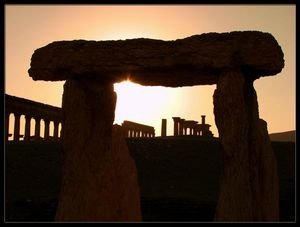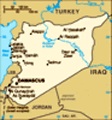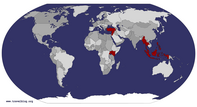Advertisement
Published: February 1st 2008

 Sunset
Sunset
Ruins of PalmyraGo back the timeline for a thousand years or more and imagine a caravan in the Syrian Desert, coming all the way from the far East, travelling along the silkroad from oasis to oasis, through a seemingly endless landscape of sand, rocks and stones, and then out of the sudden, somewhere in the middle of nowhere, one of the most graceful and splendid ancient cities of the Middle East with green palms, great Colonnades and temples for the gods... rises from the sands, rises right in front of your eyes.... like the Fata Morgana of a seductive beautiful woman, a Queen... a powerful, majestic Queen of the Desert: "Palmyra" or "the City of Palms"...
There is no doubt that back then Palmyra must seemed to be like a pearl in the heart of the Syrian Desert, a green oasis surounded by sand and stones. An astounding beauty. But as time goes by, and as everything in this world is perishable, even the most stunning beauty will fade with time, like a flower will bloom and fade away, like everything in life.
So, a thousand years after it's bloom, what is left from the once called "Queen of the Desert",

 Sunset
Sunset
Palmyra, Syrian Desertare mere ruins in the sand, old stories written down in dusty books and tales told by beduins or whispered softly by the desert wind...
- The Ruins of Palmyra - Before I started my journey I thought that Palmyra would be one of the highlights of Syria and marked it as a "must go" destination. Indeed it's the most famous sight of the country and probably the most popular tourist destination in Syria, as the ancient ruins are a World Heritage Site, so that every tourist bus will drop by. You can't possibly go to Syria and not seeing Palmyra. But then when I finally get there things turned out to be different than I expected… like so often in life.
The bus from Damascus (2-3hrs, 2USD) dropped us in the middle of nowhere, a stop along the highway with a shop and a restaurant. We had no idea where we actually were, like how far it was to the city, as there was nothing around, just the road, the desert and some cone-huts. We had to pay someone for a ride into town, which was actually just 3km away and my first impression was "this

 Skyline
Skyline
Palmyra, Syrian Desertis a strange place"! It felt a bit like an abandoned town out of some oldschool western movies, dusty and forgotten - almost like a ghost town.
Bearing in mind that Palmyra, 210 km northeast of Damascus, is separated by approximately one hundred kilometers from the lush valley of the Orontes, to the west and that there are more than two hundred kilometers of desert to cross before you reach the fertile banks of the Euphrates to the east, and that from both north and south there is nothing but sand and stone, it actually is a typical desert town, and somehow forgotten in the middle of nowhere.
But then, here at Palmyra a spring rises out of a long underground channel whose depth has never been measured. This spring is called Afqa (or Ephka), an Aramaic word meaning, “way out.” Its clear blue, slightly sulphurous waters are said to have medicinal properties, and they have fed an oasis which made this place to one of the most important cities in the past, between Rome and the east, as it provided a water source and a place of trade for desert caravan routes throughout the Mediterranean and the

 Faces
Faces
This Syrian boy told me that he can make all kind of faces... liks this suppose to be: AngryMiddle East.
With the rise of the great civilizations of the Ancient World the trade between East and West became a highly organized and lucrative business, given impetus by the domestication of the camel. Vast quantities of staple commodities, manufactured goods and luxury items were transported along well-defined routes. For reasons of safety, traders and their pack animals usually travelled in groups, forming a caravan. Market towns appeared at the junctions of major routes, in desert oases, along the coastline and in high mountain valleys. These soon grew into prosperous and cosmopolitan caravan cities, like Palmyra.
Palmyra (Παλμυρα) is the Greek name for the city, a translation of its original Aramaic name, Tadmor, which means "palm tree." Once dubbed the "Bride of the Desert," Palmyra was even mentioned in the Old Testament as being fortified by Solomon and it flourished in Roman times.
The guy who drove us into town stopped in front of a hostel close to the ruins. I checked out the rooms while Grace would wait outside with our bags. The rooms were quite ok and a way cheaper than in Damascus. When I returned to the car Grace was gone and I thought
that she went to find something to eat. A few minutes later she returned with the manager of another hostel right on the opposite side of the road a few steps away and we decided that I should check out the other place while she would have a look at the rooms here. When we both met again on the street we weren't sure as both places were actually ok, so it was just a question of the price. As competition can do magic, both managers started immediately to undercut the price of the other. We were originally offered an aircondition room with own bath for something like 750 Syrian Pounds (15USD) before one of them said "650", the other one replied "600"... and somehow we lost track and just stood there and waited until one of them gave up... later in the room Grace asked me "How much are we actually paying now?!" and I had to admit that "I have no idea... either 400 or 350?! or was it 250? Hmm, anyway... we will see!"
As it was already afternoon we left for the ruins right after we had checked in. As Palmyra was not like Baalbek
just a temple complex but a whole ancient city, the area was huge. Depending on how much you want to see, one or two days will be needed to cover the site which requires some walking. It is not recommended to wander during the heat of the day (1 to 4 pm when the locals sensibly have lunch and take their siesta) and be sure to carry a large bottle of water, and wear a hat and put on some sunblockers. Well, we had no hats, but at least some sunblockers, though we were already tanned and didn't mind the sun too much anymore.
The extensive ruins at Palmyra reveal the network plan of the ancient city. The Corinthian order marks almost all the monuments, but the influence of Mesopotamia and Iran is also evident. The art found on monuments and tombs also reflects the influences of the surrounding Roman and Persian empires. As UNESCO puts it, "the art and architecture of Palmyra, standing at the crossroads of several civilizations, married Graeco-Roman techniques with local traditions and Persian influences."
Much of the principal east-west street, named the Grand Colonnade by archaeologists, still stands. It was originally almost one
mile long and consisted of of some 1,500 Corinthian columns.
Palmyra was not just an ordinary frontier town for Romans and Persians, but the main gateway, and for a while controlled a virtual caravan empire. Spices, perfumes, ivory and silks from the East, glass statues, and objects of art from Phoenicia, all passed through Palmyra, making it one of the greatest and weathiest cities of the Roman Empire.
But as I said before, all that was a long long time ago. Even though it's actually not too difficult to imagine Palmyra's beauty in the past while walking through its ruins, I wasn't too impressed by what I saw. I am not sure why, but it just didn't catch me, maybe it was just not the right time, not the right day for me to wander through Palmyra's great ruins and to feel something special, or I had just not the right mood to let it affect me. And it's strange that when I look at the pics I took and uploaded here, I can suddenly see a way more of the majestic of Palmyra. It's said that a picture can tell more than thousand words, and that's in

 "Let me show you some Magic..."
"Let me show you some Magic..."
...he said, turned around and walked away! "Wait! Where is the magic?!" I asked... but he did't answer... maybe that was the magic!?a way probably true. But in addition I do think that pictures can paint the world in a totally different colour, and much more, they can create an own world, an own atmosphere... so I feel different now when I look at my pics then when I was wandering through the real Palmyra.
Unfortunately I had to notice after just a few shots that all my camera batteries for my Canon S3 were empty so that I ended up taking all pics with my point and shot camera the Casio Exilim S600, which turned out surprisingly good. It's such a good thing to have a second camera handy.
The best time to arrive to the ancient ruins is 3 hours before sunset. So we get there just in time. I've read that the setting sun over the city viewed from the vantage point of Qalaat Ibn Maan is magnificent and a site not to be missed. But we didn't make it up all the way to the hill and just sat at the ruins.
The sunset was approaching and painted the horizon in a soft violet mixed with crystal blue, which was pretty. We wandered through the

 Sunken Ruins
Sunken Ruins
Palmyra, Syrian Desertruins until nightfall and walked back to the town for dinner. The simple restaurants were quite pricey, considering that we paid the same money in Damascus while dinning in upper-scale restaurants.
The town felt strange. I can't really name it, but the atmosphere was a kind of depressing. Some people were strange as well, though mostly friendly. Maybe places like this, which depends heavily on tourism and cut off the rest of he country by the desert, ends up like this. Most people who come are probably just go there for a day, walk through the ruins and jump back into their buses and leave or stay a night and leave the next morning, so that the place is at the end of the day actually nothing more or less than what it is, a town somewhere in the heart of a desert, floating in its own universe and time.
When we returned to our hostel, the manager was already waiting for us and suggested that we should have a picture of us dressing in traditional beduin clothes. He took a pic of us and I remembered that I have seen the same pic in another blog a
while ago, they were dressing in the same clothes as we were, what made me wonder if the clothes got washed now and then. Anyway, the manager turned out to be a kind of strange, with his redish hair and greenish eyes, ok though, but somehow strange... like the place and the whole town itself.
We actually planned to wake up early to watch the sunrise over the ruins but couldn't make it and ended up sleeping until noon. On the one hand we felt like leaving this town as soon as possible but then on the other hand we had to venture into the ruins again, as we still haven't seen much of it. So we spent a few more hours in Palmyra and left to the busstation to catch a ride to Hama.
I am still not sure what I should think about Palmyra. The ruins were ok, but didn't impressed me too much. Maybe my expectations were too high. But what bothered me more was the strange atmosphere of the place, coming from a vivid city like Damacus, it felt a bit dull. In addition people are very dependened on tourism, so they treat visitors

 Violet Sunset
Violet Sunset
Palmyra, Syrian Desertdifferently than in big cities, where people seem to be more genuine and life more real than what we have seen in Palmyra.
I think what leaves the biggest impression on you while travelling are always the people. There are countries I love without outstanding sites to see but beautiful, friendly people, and then there are countries with world class sites like Egypt, but people who leaves you with a bad impression of the country and just the urgent desire to leave it as soon as possible.
Because at the end of the day, it's the people who talk to you and tell you their stories, not ruins nor buildings nor landscapes. It's the people of the country who makes you feel welcomed. And despite of the bit strange atmosphere in Palmyra, Syria has warm and tremendously friendly people, what makes it a great destination for every traveller.
To be continued… next: Syria - The Castle of the Knights & the Axis of Evil...
Advertisement
Tot: 0.308s; Tpl: 0.015s; cc: 31; qc: 132; dbt: 0.1638s; 1; m:domysql w:travelblog (10.17.0.13); sld: 1;
; mem: 1.6mb






















Mingxin
non-member comment
Traditional Clothes
this foto is so funny :)